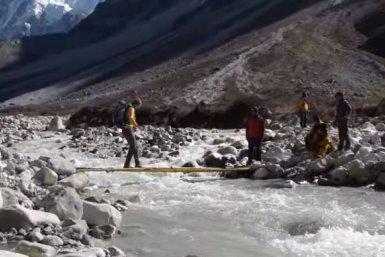Utrecht University Advances Sustainable Hydropower Development in the Upper Indus
The upper Indus basin, home to the Himalaya, Hindukush and Karakoram mountain ranges, feeds major rivers that flow through India, Pakistan, Afghanistan and China. Hydropower is booming in the upper Indus – its countries propose an over four-fold expansion in hydropower generation in the coming decades. PhD candidate Sanita Dhaubanjar explored different pathways to expand hydropower. Which way is the best, now and in the future? She will defend her PhD thesis on 29 May 2024 at Utrecht University.
Mixed strategy
Current plans for hydropower expansion promote building large hydropower plants on main rivers. “Building ‘mega plants’ is the typical political solution to this,” says Dhaubanjar. An alternative is to build a mix of small to large sized plants by considering different plant configurations that suit locations beyond the main rivers, such as smaller river branches. “Such a mixed strategy outperforms the current strategy when it comes to technical, financial and sustainable performance if we look at the whole basin.”
It is high time to consider long-term sustainability rather than just the technical potential
Sanita Dhaubanjar
Beyond technical feasibility
Hydropower planning is often based solely on technical potential – whether it is technically possible to build a power plant at a certain location. But it is imperative to ask if there are certain local policies or spatial patterns that make some location more optimal than others for building a hydropower plant? And if it is technically possible, is the cost financially feasible given the local energy markets? And how sustainable are these locations: do they allow for sustainable river flows, disrupt areas of local importance or worsen geo-hazard risks common in this region? “Given the long lasting environmental and social impacts of hydropower plants, it is high time to consider long-term sustainability rather than just the technical potential,” Dhaubanjar adds.
Over 700 sustainable locations
When all those aspects are taken into account, Dhaubanjar’s research on sustainable potential pointed out 733 potential hydropower plant locations. These new plants built under the mixed strategy would better utilise the hydropower available in the river streams, be cheaper and yield more energy, reduce conflicts over land and water use and offer more possibilities for equitable electricity access to rural and remote areas in the region compared to mega plants.
Our researchers crossing a Himalayan river
Glaciers play an important part in the water cycle.
What about climate change?
Climate change will affect the hydropower potential in the upper Indus where glaciers play an important part in the water cycle. “We analyzed 24 different climate change scenarios,” says Dhaubanjar. “Simplified: if the climate becomes colder and drier in the future, 700 plants of the mixed strategy can still operate sustainably. In an extreme – and expected – future scenario where the climate becomes warmer and wetter, that number increases to 884 because more water is available.”
The majority of the future climate scenarios suggest that the west of the basin will be worse off than the east.
Sanita Dhaubanjar
Time for energy justice
Dhaubanjar’s study finds that climate change can increase sustainable potential by as much as 50%. “Which is great, because that means there is enough room for us to think about sustainability and energy justice in hydropower planning today.” This is important because not all areas in the basin are equally suitable for sustainable hydropower development. And the effect of climate change is not equal throughout the entire basin. “The majority of the future climate scenarios suggest that the west of the basin will be worse off than the east, because the population in the west grows faster than climate induced increase in hydropower potential.”
Verify suitability
Dhaubanjar’s research and her results are a starting point for improving hydropower planning in the upper Indus. “What remains now is to take a closer look at the locations we identified and verify whether the simulated hydropower plant designs are suitable for local conditions,” she concludes.

